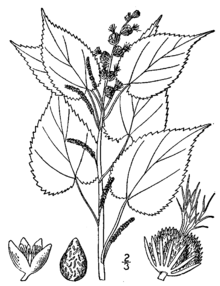Acalypha ostryaefolia
| Acalypha ostryaefolia | |
|---|---|
 | |
| Drawing of Acalypha ostryifolia | |
| Scientific classification | |
| Kingdom: | Plantae |
| (unranked): | Angiosperms |
| (unranked): | Eudicots |
| (unranked): | Rosids |
| Order: | Malpighiales |
| Family: | Euphorbiaceae |
| Tribe: | Acalypheae |
| Genus: | Acalypha |
| Species: | A. ostryaefolia |
| Binomial name | |
| Acalypha ostryaefolia Riddell | |
Acalypha ostryifolia is a plant in the Euphorbiaceae family and is commonly known as hophornbeam copperleaf or pineland three-seed mercury. It is a native of North and Central America and is generally considered a weed.[1]
Distribution
A. ostryifolia is found in the southern and eastern United States, Cuba, Dominican Republic, Haiti, Jamaica, Puerto Rico, Mexico, Guatemala, Belize, Costa Rica, El Salvador, Honduras and Nicaragua.[2][3]
Description
The hophornbeam copperleaf is an annual herb reaching a height of one to three feet. The stems are upright, branching, purplish-green with vertical striations, short recurved hairs and stalked glands. The leaves are alternate, petiolate, simple and ovate with dentate margins, a cordate base and slight pubescence. Male and female flowers are in separate spikes, the males axillary and the females terminal. The male flowers have four ovate greenish sepals often tinged red and no petals. The female flowers are also petal-less but have three styles which subdivide into white hairs which give the inflorescence a furry appearance. The fruit are green capsules with three chambers, sparsely haired, with fleshy green glandular outgrowths. The seeds are brown with low bumpy ridges. Flowering time is from June to November.[4][5]
Ecology
The hophornbeam copperleaf is a summer weed growing in cultivated fields and waste places. It has a high germination rate and the seedlings are resistant to cold and grow as fast as soybean plants in the Midwest. It is resistant to most of the herbicides used in soybean crops with the exception of lactofen, acifluorfen and fomesafen, which controlled over 80%. Lactofen was the most successful of these with a kill rate of 95%.[6]
The spotted lady beetle commonly lays eggs on this plant when it grows near sweet corn crops in Kentucky. Research has shown that the insect favoured the weed over the corn, even though it was not infested by aphids on which the larvae could feed. The larvae were found to fall from the weeds and crawl across the soil before climbing sweet corn plants. The presence of the weed in close proximity to the crop was beneficial and resulted in more beetle larvae on the crop and fewer aphids than was the case when the weed was absent.[7]
References
- ↑ USDA Plants Profile
- ↑ Germplasm Resources Information Network
- ↑ World Checklist of Selected Plant Families
- ↑ Discover Life
- ↑ SEINet
- ↑ Hophornbean Copperleaf (Acalypha ostryaefolia) Biology and Control
- ↑ Factors influencing dispersal of larval Coleomegilla maculata from the weed Acalypha ostryaefolia to sweet corn